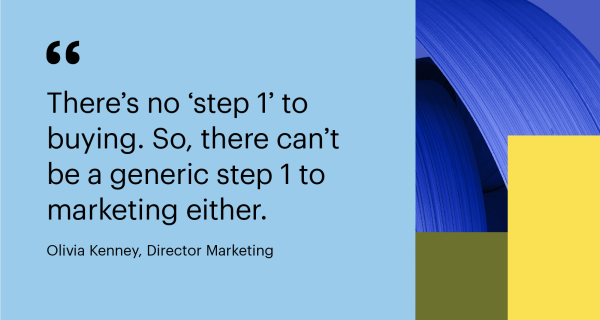The channel has been a mainstay for decades, helping vendors get their products and solutions out into the hands of customers at scale. However, the landscape transformed in the last few years, with several trends shifting the shape of the B2B buying world.
- B2B buyers are now pickier, more reluctant to talk to sales representatives and require more convincing before making a purchasing decision
- The data-driven way of doing things, digital, self-service options, and the shift towards consumption models is steadily becoming the norm, yet vendors have limited visibility into what is happening in the channel
- The emergence of marketplaces, the rise of the public cloud and the Everything as a Service (XaaS) models offer competition to the channel
These technological and competitive pressures have made channel relationships a lot more difficult, meaning that more cooperation between vendor and channel partner is required to find success.
In this article, we outline four methods to help combat the pressures facing your channel partners, enabling you to work harder and better as a team.
Whitepaper: The state of the Channel: transformation, technology and data
Take the time to understand your channel partner
First off, take time to build the relationship with your channel partner.
Remember that channel partners will wear different hats. They are selling for your competitors as well, so it pays to motivate channel partner sales reps so that they have more confidence in the revenue that your solutions will generate.
It takes time to foster that trust. Actions you can do to help with this include:
- On-boarding and training: Educate your partner extensively about your solution, not only through marketing literature and assets but also provide material such as case studies and customer reviews, which will go a long way in helping them understand why buyers choose your solution. They need a firm understanding of what your value proposition is and what differentiates you from competitors.
- Promoting together at events: Attend physical and online events together. Whether this comes as road shows, conferences, exhibitions, webinars or anything in between. Take these opportunities to promote together, and act as ambassadors of each brand, while also working to collect leads together. For example, you can launch a new product or solution at the event. Meanwhile, your channel partner can attend to gather leads and offer additional marketing support. Not only will this help form tighter bonds, it will give channel partners more hands on experience interacting with your product and potential buyers.
- Offer proactive marketing and sales support: Ensure your channel partner knows your solutions inside out. Provide key messaging that your internal sales team uses on the phone every day, and take this a step further and invite your channel partners’ sales reps to shadow sales calls to see what the best practice is for your organization. Channel partners need the ability to communicate the narrative of your brand to leads.
- Rebates and discounts: A rebate-based rewards program offers channel partners a percentage of their original purchase back, and is often based on how much volume of your product the channel partner pushes. Rebates can be a huge incentive for channel partners looking to maximize the revenue they generate, while encouraging them to consistently meet your targets.
In a similar vein, you can also offer your channel partners discounts based on the quantity of how much product they buy. For example, a 5% discount for over 100 units purchased. - Sales performance incentive fund (SPIF): A SPIF is a performance incentive that targets channel partner sales reps directly and is a great way to compensate individuals for their performance. You can be creative with the incentives you offer, ranging from gift cards and gadgets all the way to all expensive weekend getaways and extravagant dinners.
- Look at the data: As with any project your organization undertakes, it is essential to measure KPIs to get a solid picture of performance and areas of improvement. The type of data you measure will depend on the relationship you have with your partners, and the technologies available to both parties to facilitate performance tracking.
Here are some performance metrics that will help you keep on top of performance, providing you with the data to take steps to improve the relationship.- Active Pipeline Value: The revenue generated by your channel partners
- Opportunities per partner: The opportunities each partner generates and their value
- Training completion: The number of channel partner sales reps that have completed your introductory training, showing their level of investment
- Partner satisfaction: Metrics that help show how satisfied the channel partners are with the relationship
Customer satisfaction: Metrics that help show how satisfied leads and customers are when they are engaged by the channel partner.
Learn more: Why aren’t your channel partners hitting sales targets?
Take more ownership of your leads
The B2B market has changed, but the relationship between channel partner and lead is largely the same. Vendors pass leads onto their channel partners and hope that they will turn them into buyers.
However, as we established above, the B2B buyer now requires more nurturing than ever before in order to make a purchasing decision. This can only happen through education. Leads want to know that their business challenges are understood, and that vendor solutions will clearly help.
This is a process that takes time and effort, as leads have to be led through a program of relevant, practical and educational content. To understand what makes each lead tick, requires data from lead qualification and lead scoring efforts.
Unfortunately, most channel partners will not have the time or resources to approach leads in this way.
But consider the fact that your own sales team wouldn’t want to spend their day talking to Marketing Qualified Leads (MQLs) that have a very low chance of becoming a buyer. Your channel partner doesn’t want to either.
Resist handing over your MQLs because the conversion rate will be much lower compared to handing them Sales Accepted Leads (SAL). Give your channel partners a helping hand by separating the high quality leads from the low quality leads, and ensure you are only sending leads that have been qualified and scored, and are more likely to convert. Your channel partner will thank you for it.
By cutting the wheat from the chaff, you are being proactive in your channel partner relationship. And if you are actively feeding them with higher quality leads that are easier to sell to, when compared to your competitors, your channel partner will prioritize your business.
Learn more: Tips to nurture marketing qualified leads to sales accepted leads
Use technology to help manage your channel partner relationship
The importance of the channel partner as a driver for growth has led to an increase in solutions and technologies for vendors to help manage channel partner processes, and many of the steps above wouldn’t be possible without technology to facilitate it.
Some studies show that around half of vendors use technology solutions to manage elements of their channel programs, such as:
- Training and onboarding
- Incentive programs
- Channel partner relationships and communication
- Partner recruitment
- Co-selling
- Co-marketing
Many of these technology solutions fall under the umbrella of automating processes between the vendor and channel partner, streamlining time-consuming activities and routines, while freeing up time for more value-adding tasks. Here are some technology types that you can use to streamline your channel relationship:
Partner relationship management (PRM)
A PRM is a tool that is tasked with managing the relationship between a vendor and its channel partner, focusing on facilitating product sales. It is quite similar in scope to the all-encompassing nature of a Customer Relationship Management (CRM) tool that is built to manage the processes of direct sales, but instead PRMs are focused on managing indirect sales.
Some features include:
- Partner portals: The most important feature of a PRM, a partner portal is a dedicated space to manage each of your channel partners, providing an easy way to find leads, opportunities and gain oversight of the actions that channel partners are taking.
- Lead management: A lead management feature will help ensure that your channel partners only receive SALs that are worth chasing. It will streamline lead tracking, handover, as well as automatically update the status of leads after they have been engaged.
Training and onboarding: Training and onboarding are often also covered by PRMs. This feature enables the vendor to have easily accessible training and marketing materials that the channel partner can access. More in-depth solutions might also offer the ability to create training programs–guided or self-guided–that channel partner sales people can complete, giving them more confidence in selling your brand.
Through-channel marketing automation (TCMA) - A TCMA is a tool to automate indirect sales marketing at scale. It does much of the legwork required to create marketing campaigns, enabling your channel partners to use your messaging and marketing strategies to sell your products quickly and efficiently. Vendors can distribute messaging, persona, brand style and more – which goes a long way in plugging the marketing skills gap that is typically innate with channel partners, while also ensuring the vendor’s brand message is followed.
TCMA tools are, ideally, easy to use and customizable. This ensures that vendors have entire campaigns on hand just a few clicks away, with access to vendor marketing assets, logos, brand pallets, style guides, marketing workflows, imagery, campaign tools – and more.
Channel learning and readiness (CLR)
CLR tools help the vendor and channel partner relationship through tracking, administration, lending and management, certification management and sales enablement as some of the core features. This technology type has features associated with channel learning and channel readiness.
Learning refers to gaining more information about the vendor, leads, product, challenges and industry. Meanwhile, the readiness side is focused on the skills for successful lead engagement, such as being able to communicate product value propositions while understanding [KH1] lead challenge areas.
Channel incentives management (CIM)
CIMs are tools that facilitate incentive programs that will motivate channel partner sales people to reach vendor goals and expectations. Similar to loyalty programs we see in the B2B world, CIMs work by offering rewards for completing certain actions, and encourage loyalty to selling for your brand.
Whitepaper: Technology for sales development: a guide for decision-maker
Put your channel partner at the forefront of lead nurturing
What exactly is lead nurturing? It is the process of guiding a lead from a state of consideration to where they are ready to make a purchasing decision. It is the step that takes
MQLs and turns them into SALs.
To do this, leads have to be thoughtfully engaged in a way that makes them feel that pain points are understood, the product will effectively help solve these challenges, and that any decision making results from their own research.
Because of this, it is vital that vendors and resellers work together to identify valuable leads in the funnel as easily as possible.
Vendors and channel partners can analyze behavior and lead intent data to identify buying signals, challenge priorities are, and industry buying trends. This information will paint a detailed picture of the lead, which can be leveraged by channel partners to better engage with them.
You can gather intent data in the following ways:
First-party data: This data type is owned by the vendor or channel partner. This type of data captures visits to the vendor/reseller website, app and social interactions, subscription data, customer feedback, recorded event attendance, survey responses and inbound emails.
Second-party data: This data type refers to capturing data that is owned by another party and can be obtained, typically through a partnership or fee. For example, business partners, or data co-ops and media owners.
Third-party data: Third-party intent data is collected from websites that the seller doesn’t own, such as intermediaries. It looks outwards and takes into consideration the fact that prospect decision-making is multifaceted, and is not only based on the lead, but also other stakeholders and colleagues in the organization.
Learn more about lead scoring: Your lead scoring workbook
Work with Foundry Sales Development Services
Sending your channel partners every lead you have without direction is a recipe for low conversion and wasted resources. Vendors, along with their channel partners, should engage with each other as early as possible to discuss:
- What makes a sales qualified lead?
- When should leads pass from the vendor to the channel partner?
- What are the most effective lead nurturing strategies for the lead type?
- What is the make-up of the ideal buyer?
- What is the goal for a lead nurturing campaign?
- What is the lead scoring system?
- What is the lead qualification system?
Forward-thinking vendor and channel partner relationships that can answer these questions and have aligned lead nurturing processes will understand and engage leads on a more meaningful level.
This is a long and resource-intensive process, requiring an effective command of lead data, robust lead tracking capability and lead qualification and scoring technologies.
But this can be difficult to implement in a B2B market characterized by waves of disruptive change on multiple fronts, not to mention the ever-present requirement to deliver revenue growth and protect margins.
Similarly, channel partners rarely have capacity, technology, or willingness to work with you to nurture leads and unearth high-quality opportunities.
Fortunately, Sales Development Services teams, such as Foundry SDS are at the cutting edge of using data to nurture leads and exploit high-quality prospects.
To help improve your working relationship with your channel partner, enlist the help of an expert Sales Development Services team.
Used as a bridge between your organization and your channel partner, we can act as an extension of your organization and provide the expertise to score, qualify and nurture leads. This way, channel partners are empowered to do what they do best, sell to leads with a strong chance of buying.
Foundry SDS will create a bespoke lead nurturing program to deliver high-quality leads that fit the buyer persona of your business development strategy, and work with your channel partner to ensure they are engaged effectively.
For more on how we can supercharge your channel partner relationship, visit: Our services
Want to learn more about enhancing your channel relationship?
Whitepaper: The state of the Channel: transformation, technology and data





